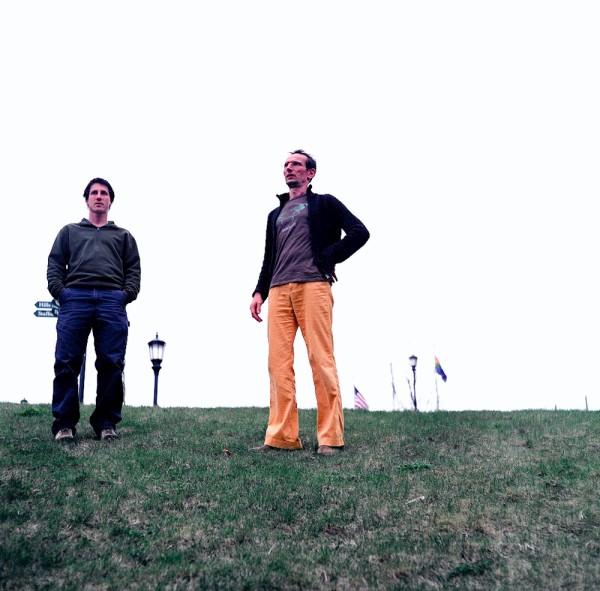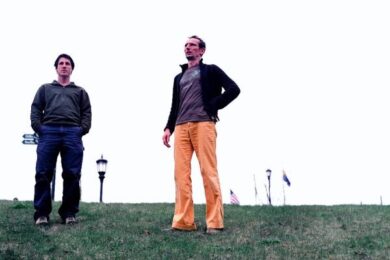Nick Zammuto and Paul de Jong were living in the same New York apartment building when they met in 1999. Forming The Books, they released their first album, Thought For Food, in 2002. Sophomore effort, The Lemon of Pink, followed a year later.
Setting obscure spoken vocal samples amongst snippets of looped acoustic instrumentation, The Books’ patchwork melancholy struck a balance between the obtuse and the accessible that appealed broadly and they soon established a sizeable international following.
Their third record, Lost and Safe, was The Wire’s album of the year in 2005, and Scott Herren remixed a number of their tracks on the Prefuse 73 Reads The Books EP, but since then things have been eerily quiet.
Or so I thought.
It turns out The Books have just brought out a new album, The Way Out, on Temporary Residence. I spoke to them about it via a crackly, transatlantic conference call.
It’s been quite a long time since your last studio album. What have you been up to in the meantime?
Nick Zammuto: Paul, did you hear that?
Paul de Jong: No, not at all. I hardly heard a word of it.
NZ: He’s asking us about our hiatus. Where we’ve been all this time.
PDJ: For myself I’ve had time to generate a much larger sound library than we’ve ever worked with before, from the LPs and videotapes that we find in thrift stores in cities we’ve played in. We’ve had access to so many countries- going on tour really brings a chance to build up a library.
NZ: As Paul was saying, we started picking up at thrift stores all these VHS tapes, audiotapes and vinyl. And Paul has been going through the tapes.
Have the tracks you’ve been making for the album come gradually, or are they something you’ve been working on recently?
NZ: Composing started earnestly a year and a half ago, something like that, but before that we were building the library. At that point we had no idea which direction we’d go in.
What draws you to the recordings you use?
NZ: The general rule of thumb for sample material is that we’re interested in tapes that are homemade, or obviously not from a production company, maybe instructional tapes or videos for products. What we’re drawing from is kind of literally on the way out, which is the title of the record.
PDJ: It’s an intuitive process I suppose. You know you’re interested in something that has an outstanding quality or maybe a combination of qualities: if it makes you happy or sad in some respect, something that is a good sound, although it might be just a fragment. It might be something funny, something that’s musically or artistically very rich, sonically very rich, if it’s literary or very profound. It can stand out by itself and that makes it very interesting for the re-appropriation of life into music.
What about a track like ‘The Story of Hip Hop’? I wondered if it was the words themselves, the tone of the voices, the rhythm of the sounds…
NZ: All those things. When they combine on something together it sort of goes beyond belief. ‘The Story of Hip Hop’, that was a very old LP, where there were four children’s stories. One of them was about Hip Hop the grasshopper. It was an LP probably from the late 50s.
Do the tracks you build always start with the samples you use?
NZ: The sample library is the primary instrument of The Books. The sample library always starts the track, provides the inspiration for it. As Paul is making the library samples I’m always making musical sketches. A track doesn’t really start until we marry the two together.
Where does the interest in working with found sounds come from?
NZ: Neither of us finds the contents of our heads particularly interesting, at least in terms of wanting to share it with people, and there’s all this ego stuff in there and there’s emotional stuff, and I don’t feel the need to pour that out.
It’s much more interesting, a live input. Instead of starting with a blank canvas, rather than, I don’t know, just a sort of vomit – pouring your heart out and making meaning out of it – it’s more like a collage approach I suppose.
You’re trying to find your place in the world gradually, or channelling energies that aren’t completely in your control. Finding a connection between things you don’t immediately see. I always think about it like the world is a pretty oblique place and you can maybe take the reins.
There’re a couple of tracks on the new record on which it sounds like you’re employing fewer samples. They’re also really quite downbeat. Would you agree with that? Where did those ones come from?
NZ: I think that it comes from an approach we started taking on our last record. That’s not to say there aren’t samples on them. They’re just not audio samples. A lot of the lines were taken directly from the notes we generated while listening to a lot of audiotapes. In the case of ‘We Bought the Flood’, we were watching a lot of videotapes, and when you took the video away that’s what we were left with.
Is this record one you feel differently about, compared to the previous ones?
PDJ: Yeah, it’s impossible not to. So much time has passed. Our personal life, our musical life, everything we’ve heard and seen and experienced in five years. It’s impossible not to think about it differently. It doesn’t mean that it’s better or worse. It’s got a life of its own.
What’s different for you?
NZ: The big thing that changed for both of us is having kids. When a child is born a parent is born. It’s an incredible experience. Being able to live vicariously through a child’s eyes is an amazing experience. It pretty much completely rewired who I was.
PDJ: My daughter runs around the house and every once in a while she blurts out, "I didn’t know that!"
NZ: I think making a record is like having a child. They’ll never come out quite how you think they will. It’s amazing, both of my boys have so many innate qualities that I can’t explain. I don’t know where they came from, and I feel the same about records. They just have a sound and sometimes it’s hard to explain how that happens.
I’ve got a poster in my studio. It’s the only one that survived a recent clean out. It’s a picture of three guys at an airport, like they’re waiting to pick somebody up. They’re holding up signs and the artist has replaced the names with the words, "I am a hole in a flute." That’s kind of how I feel.
That seems to be kind of an apt metaphor.



